
The Future of App Marketing: Emerging Trends and Predictions
The world of app marketing is in a constant state of evolution, marked by innovation, technology advancements, and shifting consumer behaviors. App developers and marketers find themselves navigating a dynamic landscape where staying ahead of emerging trends is not just an advantage but a necessity.
As we embark on this journey into the future of app marketing, we catch a glimpse of what lies ahead. From evolving strategies to the adoption of cutting-edge technologies, this article explores the trends and predictions shaping the destiny of app marketing.
App marketing is no longer confined to traditional methods; it’s an ever-evolving ecosystem that demands adaptability and foresight. This article serves as a guide to understanding the changing landscape, and it emphasizes the importance of staying adaptable and open to new strategies.
Emphasizing the ever-changing landscape of app marketing: In the fast-paced world of technology, what works today may become obsolete tomorrow. Successful app marketing means staying updated on emerging trends, harnessing innovative technologies, and making data-informed decisions.
The importance of staying adaptable and open to new strategies: App marketing isn’t a static concept. By embracing emerging trends and remaining open to innovation, app developers and marketers can create strategies that are future-proof and capable of navigating the uncharted territory of the app marketing landscape.
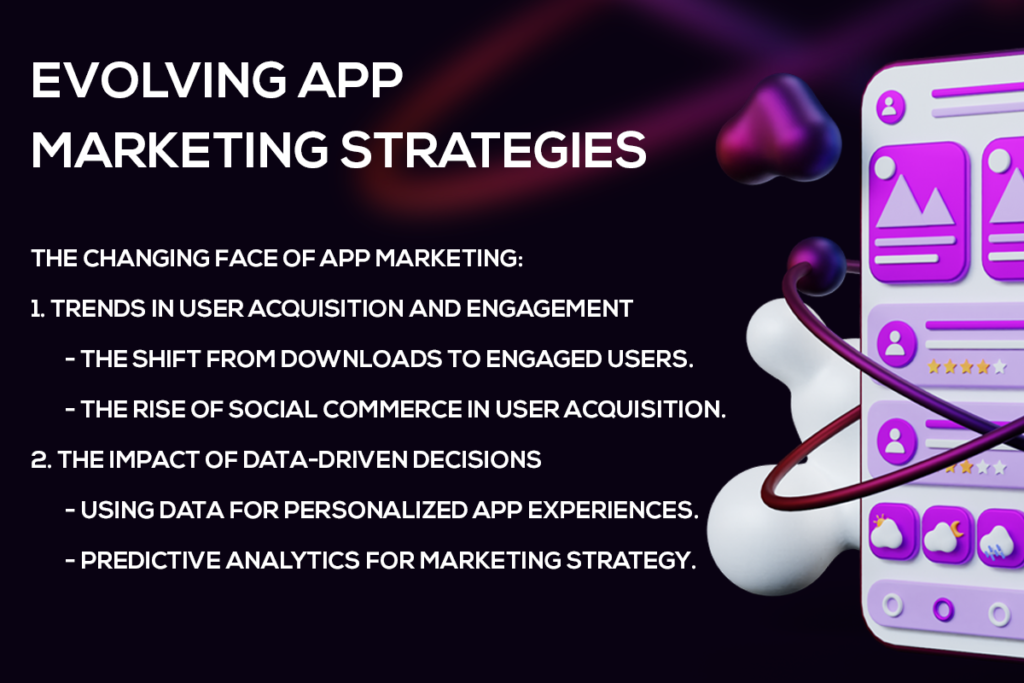
Evolving App Marketing Strategies
The Changing Face of App Marketing trends
The realm of app marketing is undergoing a significant transformation, driven by changing user behaviors and evolving market dynamics. This section delves into the shifts and innovations that are reshaping app marketing strategies.
Trends in User Acquisition and Engagement
In the past, the success of an app was often measured solely by the number of downloads it could amass. However, this simplistic metric no longer tells the full story. App marketers are now realizing that downloads alone don’t guarantee a thriving app ecosystem, and the focus is shifting toward user engagement and retention. Here, we delve into the emerging trends that are shaping the way app marketers acquire and engage users.
The shift from downloads to engaged users
Once upon a time, the number of downloads an app could boast was the ultimate metric of success. But times have changed, and the focus has broadened. Acquiring users is just the first step; the real measure of success is in engagement and retention.
In today’s landscape, the name of the game is “engaged users.” App developers and marketers have realized that a large number of downloads is meaningless if users don’t actively engage with the app. An engaged user base is more likely to continue using the app, make in-app purchases, and spread positive word-of-mouth.
This trend is transforming the way app marketing strategies are designed. Instead of concentrating solely on acquisition campaigns, marketers are increasingly investing in user engagement and retention efforts. This includes creating compelling in-app experiences, personalized content, and loyalty programs to keep users coming back for more.
The rise of social commerce in user acquisition
Social media platforms are no longer just virtual spaces for sharing updates and connecting with friends. They’ve evolved into interactive marketplaces, redefining the way apps acquire users. Social commerce, a phenomenon where users can discover, explore, and purchase products without leaving their favorite social platforms, is on the rise.
This shift has transformed the user acquisition landscape. App marketers are leveraging social commerce to engage users where they spend most of their time. Platforms like Instagram, Facebook, and Pinterest have integrated shopping features that enable users to seamlessly discover and purchase products, blurring the lines between social interaction and shopping.
As app marketers increasingly tap into this trend, the rules of user acquisition are changing. Social media campaigns now play a pivotal role in driving app installs. Additionally, the integration of in-app shopping and social sharing features is reshaping how apps engage with their audience.
The Impact of Data-Driven Decisions
In the world of app marketing, data has become the North Star guiding marketers to their destination. The impact of data-driven decisions is profound, enabling app developers to fine-tune their strategies, deliver personalized experiences, and make informed choices based on user behavior and preferences.
Using data for personalized app experiences
Data is the linchpin in creating personalized app experiences. By collecting and analyzing user data, app developers can tailor their offerings to individual preferences. This level of personalization not only enhances user satisfaction but also boosts engagement and conversion rates.
From suggesting personalized content to recommending products and services based on past interactions, data-driven personalization has a significant influence on the success of app marketing. Users are more likely to engage with and remain loyal to apps that understand and cater to their individual needs and preferences.
Predictive analytics for marketing strategy
Predictive analytics, fueled by machine learning algorithms, are revolutionizing marketing strategies. By analyzing historical user data, predictive analytics can forecast user behavior, helping app marketers anticipate their audience’s needs and preferences.
This means that marketing efforts become more precise and efficient. For example, predictive analytics can predict which users are more likely to make in-app purchases, allowing marketers to target their efforts on these individuals. It can also help in predicting when users are most likely to engage with an app, optimizing the timing of marketing campaigns.
The power of data-driven decisions lies in their ability to ensure that marketing efforts are not wasted but are directed toward strategies that are more likely to yield success. This is not just a trend; it’s a fundamental shift in how app marketing is approached and executed.
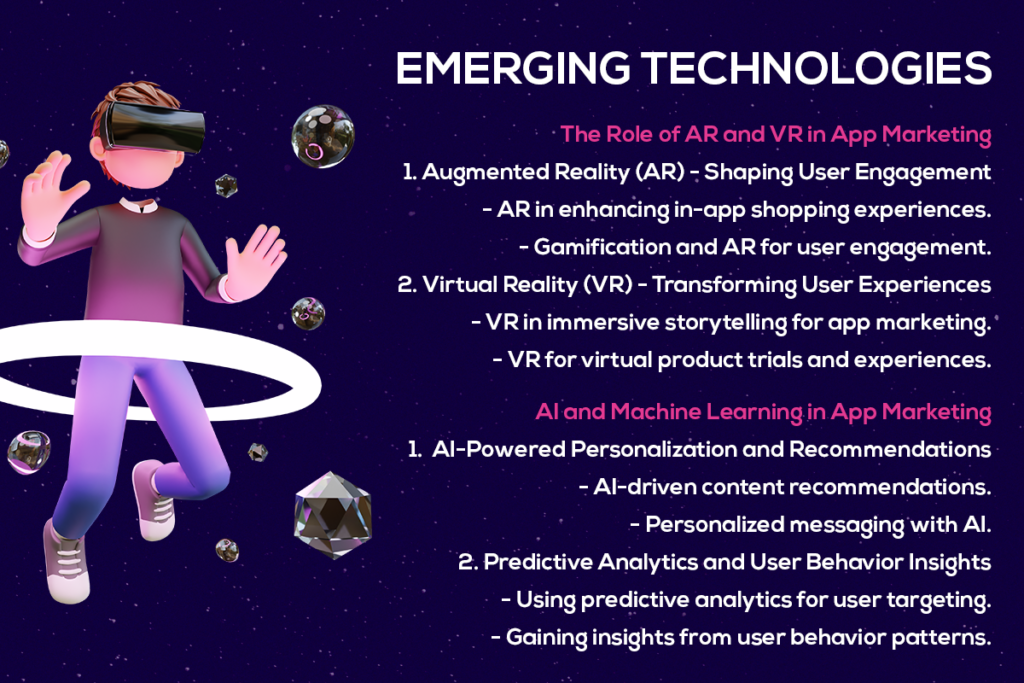
Emerging Technologies
Emerging technologies are reshaping the landscape of app marketing trends. This section delves into the pivotal role of Augmented Reality (AR), Virtual Reality (VR), Artificial Intelligence (AI), and Machine Learning in creating engaging and immersive experiences for app users.
The Role of AR and VR in App Marketing
Augmented Reality (AR) and Virtual Reality (VR) are not just buzzwords; they are reshaping the app marketing landscape, offering innovative ways to engage and captivate users.
The synergy between AR and gamification in app marketing is evident in the level of user engagement and interaction it generates. Users are drawn to apps that provide these unique and entertaining experiences, making AR a powerful tool for app marketers.
Virtual Reality’s ability to offer immersive and lifelike experiences is transforming user interactions within app marketing. Users are drawn to apps that provide these unique and captivating experiences, making VR an influential tool for app marketers.
Augmented Reality (AR) – Shaping User Engagement
Augmented Reality (AR) is redefining the concept of user engagement in app marketing, offering a range of innovative possibilities that captivate and immerse users. Here are more specific ways AR shapes user engagement:
AR in enhancing in-app shopping experiences
- Virtual Try-On: AR allows users to virtually try on products, from clothing to eyeglasses and makeup. They can visualize how a product looks on themselves or in their environment, enhancing the shopping experience.
- Interactive Product Previews: Apps can offer interactive product previews through AR. Users can explore product features, details, and functionalities in a highly engaging manner, leading to informed purchase decisions.
- Visualizing Interior Design: In the home decor and furniture industry, AR empowers users to visualize how a piece of furniture or decor item fits within their own living space. This feature significantly boosts user engagement and conversions.
- Increased Confidence: By enabling users to visualize products in their real-world context, AR instills confidence in their purchase decisions. They no longer need to guess; they can see the product’s suitability firsthand.
Gamification and AR for user engagement
Gamification is a potent technique for enhancing user engagement, and AR seamlessly integrates with this strategy. Here’s how AR and gamification work together to engage users:
- Scavenger Hunts and Quests: Apps can create interactive scavenger hunts or quests using AR technology. Users are encouraged to explore the app and its offerings in a playful and challenging manner, resulting in longer session times and increased engagement.
- Rewards and Prizes: AR-based gamification often incorporates rewards and prizes. Users who complete challenges or missions can earn virtual rewards, discounts, or even real-world incentives. This entices users to stay engaged with the app.
- Interactive Storytelling: AR can take storytelling to a whole new level by involving users in immersive narratives. For instance, users can follow a character’s journey by interacting with elements in their real environment, creating an emotional connection and deepening engagement.
- Educational Experiences: AR-driven gamification can be used for educational apps. Users can engage with educational content in a fun and interactive way, improving their learning experience and retention.
Virtual Reality (VR) – Transforming User Experiences
Virtual Reality (VR) is revolutionizing user experiences within app marketing, offering immersive and lifelike interactions. Here are more specific ways VR transforms user experiences:
VR in immersive storytelling for app marketing.
- Immersive Narratives: VR allows users to step into and become part of narratives, creating an unparalleled level of immersion. For example, travel apps can offer virtual tours of destinations, where users can virtually explore and experience the sights and sounds of a place before deciding to visit.
- Virtual Product Trials: In industries such as automotive and interior design, VR enables users to virtually test drive cars or visualize how furniture and decor items fit within their own spaces. This empowers users to make informed decisions, boosting user confidence and engagement.
- 360-Degree Experiences: VR often includes 360-degree visuals, enabling users to look around and interact with their surroundings. This level of interactivity is especially effective for real estate and travel apps, where users can explore properties or destinations from every angle.
- Enhanced Learning: Educational apps are leveraging VR for immersive learning experiences. Users can engage with historical events, scientific concepts, or even virtual dissections in a way that makes learning more engaging and memorable.
VR for virtual product trials and experiences.
- Try Before You Buy: In e-commerce, VR can offer a virtual fitting room experience. Users can see how clothing and accessories look on themselves, potentially reducing returns and enhancing user satisfaction.
- Virtual Tours: Apps can provide virtual tours of properties, hotels, or tourist destinations. Users can explore these spaces as if they were physically present, making travel and accommodation decisions more informed.
- Immersive Training: VR is a powerful tool for employee training and onboarding. Users can undergo realistic training scenarios in a safe and controlled virtual environment, which can lead to better retention and skill development.
- Entertainment and Gaming: VR provides unparalleled gaming experiences. Users can immerse themselves in virtual worlds, interact with characters, and engage in activities that were previously impossible within traditional gaming.
AI and Machine Learning in App Marketing Trends
Artificial Intelligence (AI) and Machine Learning (ML) are pivotal in revolutionizing app marketing, offering dynamic and data-driven strategies that enhance user engagement, increase conversion rates, and improve overall app success. Here are more specific ways AI and ML are transforming app marketing trends:
AI-Powered Personalization and Recommendations
- AI-Driven Content Recommendations: AI analyzes user behavior and preferences to provide tailored content recommendations. Whether it’s suggesting articles, products, or services, this personalization enhances user engagement and conversion rates.
- Personalized Messaging with AI: AI-driven chatbots and messaging systems provide users with personalized assistance and support. They can answer queries, make product recommendations, and guide users, leading to a more user-centric experience.
- Dynamic Pricing Optimization: Apps can utilize AI algorithms to dynamically adjust pricing based on factors like demand, competition, and user behavior. This pricing strategy can maximize revenue and user engagement.
- Customer Segmentation and Targeting: AI can categorize users into segments based on their behavior and preferences. Marketers can then create targeted campaigns that resonate with specific user groups, increasing the chances of conversion.
Predictive Analytics and User Behavior Insights
- Using Predictive Analytics for User Targeting: AI and ML models can predict user behavior and preferences. Marketers can use this information to target users with relevant offers or content, making app interactions more personalized and engaging.
- Gaining Insights from User Behavior Patterns: AI can analyze large datasets of user behavior to identify patterns and trends. These insights help app marketers understand user preferences and optimize app content for better user engagement.
- Churn Prediction: AI can predict which users are at risk of churning (leaving the app). This allows marketers to implement retention strategies, such as offering special incentives or personalized content, to keep users engaged.
- A/B Testing Automation: AI can automate the A/B testing process, enabling faster and more accurate experiments to optimize app elements like design, messaging, and user flows. This leads to improved user engagement and conversion rates.
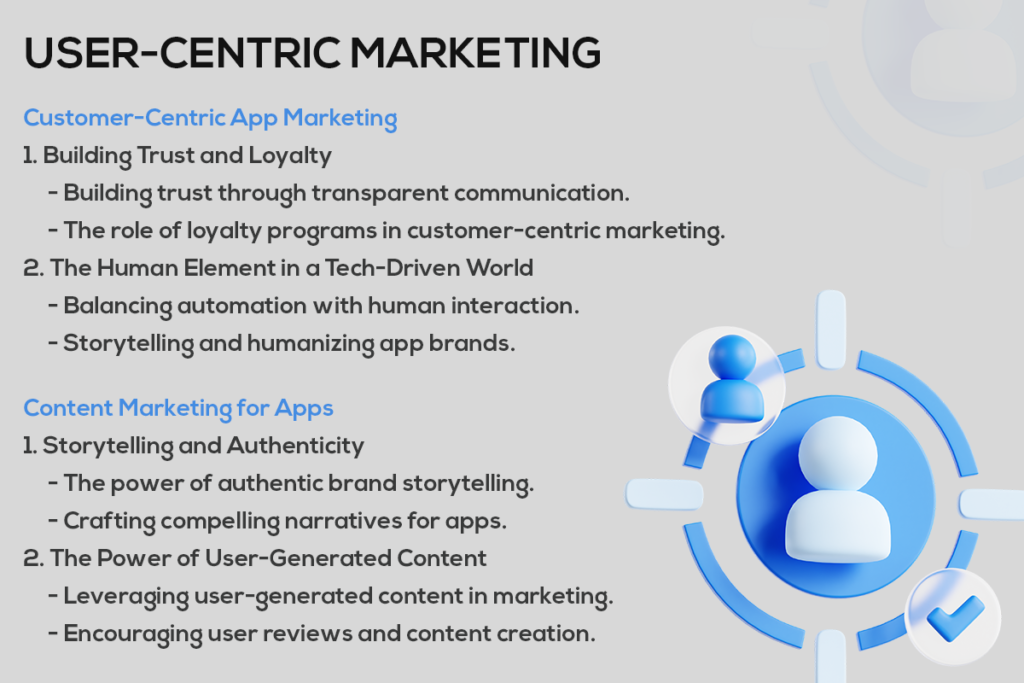
User-Centric Marketing
In the dynamic world of app marketing, user-centric approaches are gaining prominence. Prioritizing users’ needs, expectations, and experiences is pivotal for sustained success. Here’s an elaboration of User-Centric Marketing:
Customer-Centric App Marketing
Customer-centric app marketing centers around users’ needs, preferences, and experiences. It focuses on building trust, fostering loyalty, and delivering personalized interactions. Here are specific aspects of customer-centric app marketing:
Building Trust and Loyalty
Customer-centric app marketing places the user’s needs, satisfaction, and loyalty at the forefront. Here’s a more comprehensive look at the key aspects:
Building trust through transparent communication
Transparent communication is paramount. Users need to know how their data is used, how their privacy is protected, and the intentions of the app. Providing this information builds trust and enhances the app’s brand reputation.
- Clear Data Usage Policies: Apps should have clear, easy-to-understand data usage policies that outline what data is collected, how it’s used, and how it’s protected. Users appreciate knowing how their information is handled.
- User Consent and Control: Empower users by providing options to control their data. This includes preferences for data sharing, tracking, and privacy settings. Users feel more in control of their data, leading to increased trust.
The role of loyalty programs in customer-centric marketing
Implementing loyalty programs can be a powerful strategy for retaining users and fostering loyalty.
- Rewarding User Loyalty: Loyalty programs offer users rewards, discounts, or exclusive access based on their interactions with the app. This incentivizes users to engage more and remain loyal.
- Building a Community: Loyalty programs can help build a community of dedicated users who feel a sense of belonging and exclusivity. This sense of community enhances brand loyalty.
- User-Centric Perks: Tailor loyalty program perks to match user preferences. For instance, an e-commerce app could offer early access to sales events or personalized product recommendations.
The Human Element in a Tech-Driven World
Customer-centric app marketing is all about understanding, valuing, and retaining users. By prioritizing trust, loyalty, personalized support, and authentic brand stories, apps can create an environment where users feel valued and respected.
Balancing automation with human interaction
While automation is efficient and convenient, human interaction remains a vital part of customer-centric app marketing.
- Real-Time Support: Users often seek real-time support and assistance. This may involve live chat, customer support agents, or chatbots that can provide instant answers to user inquiries.
- Personalized Assistance: Human interactions can offer personalized assistance. Understanding user needs and preferences allows for tailored recommendations and support, leading to better user experiences.
Storytelling and humanizing app brands
Storytelling is an effective tool in customer-centric marketing, enabling apps to connect with users on a personal level.
- Authentic Brand Storytelling: Authenticity is crucial. Sharing genuine brand stories, experiences, and testimonials adds credibility and fosters connections with users.
- Creating Emotional Connections: Compelling narratives that evoke emotions can create deep connections with users. Users become emotionally invested in the brand, leading to increased loyalty and advocacy.
- Community Engagement: Engaging users through storytelling can build a community of brand advocates. Users who resonate with the brand’s story are more likely to spread the word and recommend the app to others.
Content Marketing for Apps
Content marketing plays a pivotal role in app marketing by creating engaging and valuable content that attracts and retains users. Here’s a detailed exploration of this crucial aspect:
Storytelling and Authenticity
Storytelling is a powerful tool in content marketing for apps, especially when it’s authentic and resonates with users.
User-generated content is a dynamic force in content marketing that transforms users from passive consumers to active contributors. It builds trust, fosters engagement, and strengthens loyalty, making it an invaluable strategy for app success.
Here’s an in-depth look at the importance and strategies involved in authentic storytelling:
The power of authentic brand storytelling
Authentic storytelling is about being genuine, transparent, and relatable. When an app shares authentic stories, it creates a connection with users based on trust and common values.
- Genuine Brand Narratives: Authentic storytelling begins with the app’s own narrative. This narrative should reflect the app’s mission, values, and real user experiences. Sharing the journey, challenges, and achievements of the app builds trust.
- Transparency and Honesty: Authenticity also means being transparent about the app’s operations, data usage, and privacy policies. Users appreciate honesty and clarity about how their data is handled.
- Consistency and Reliability: Consistency in messaging and behavior is key to authenticity. When the app consistently aligns with its values and promises, users can rely on it.
Crafting compelling narratives for apps
Effective storytelling involves crafting narratives that engage users emotionally and intellectually.
- Using Emotions: Emotions are a powerful storytelling tool. Stories that evoke emotions, whether joy, empathy, or inspiration, resonate deeply with users.
- Relatable Scenarios: Stories that feature relatable scenarios and challenges users may encounter create a sense of empathy and connection. Users should feel that the app understands their needs.
- Highlighting User Success Stories: Sharing success stories of actual users who have benefited from the app adds credibility and shows the app’s impact in real life.
Enhancing Brand Reputation
Authentic storytelling enhances the app’s brand reputation and trustworthiness.
- Building Trust: When users perceive the brand as genuine and transparent, it fosters trust. Trust is a foundational element in user engagement and loyalty.
- Fostering Loyalty: Authentic storytelling can lead to user loyalty. When users feel a strong connection to the brand, they are more likely to continue using the app and recommending it to others.
- Positive Brand Image: Authentic storytelling helps shape a positive brand image. Users view the app as reliable and ethical, which can boost its standing in the market.
The Power of User-Generated Content
User-generated content (UGC) has become a driving force in content marketing for apps, enabling users to actively engage and contribute to an app’s success. Here’s a closer look at the significance of UGC:
Leveraging user-generated content in marketing
User-generated content often begins with reviews and testimonials from satisfied users.
- Harnessing Social Proof: Positive reviews and testimonials serve as powerful social proof, reassuring potential users that the app is reliable and valuable.
- Authentic Recommendations: When users share their genuine experiences and satisfaction, it’s perceived as more authentic and trustworthy compared to brand-created content.
- Building Trust: UGC fosters trust. Users are more likely to trust fellow users’ opinions and recommendations over traditional advertising.
Encouraging user reviews and content creation
Apps can actively encourage users to create their content, further building a sense of community and engagement.
- Championing User Stories: Apps can create initiatives that invite users to share their stories, experiences, and creative uses of the app.
- Challenges and Contests: Hosting user-generated content challenges and contests can spark creativity and engagement. For example, asking users to submit videos or artwork related to the app can be highly engaging.
- Incentives and Recognition: Recognizing and rewarding users who contribute UGC can motivate others to participate. Apps can offer prizes, shout-outs, or exclusive access to features as incentives.
Sharing User-Generated Content Across Channels
To maximize the impact of UGC, apps should strategically share this content across various channels.
- Social Media Sharing: User-generated content can be shared on the app’s social media platforms, engaging a wider audience.
- Website Showcases: Creating dedicated website sections or showcases for user-generated content can further spotlight and celebrate user contributions.
Engagement and Community Building
UGC can lead to vibrant user communities, fostering deeper engagement.
- Moderation and Interaction: Apps should actively moderate and interact with user-generated content to maintain a positive and respectful environment.
- Feedback Loops: Encouraging users to provide feedback and suggestions through UGC can lead to valuable insights for app improvement.
Long-Term Loyalty and Advocacy
UGC plays a vital role in creating long-term user loyalty and advocacy.
- Becoming Brand Advocates: Users who actively contribute UGC often become strong brand advocates, promoting the app to their networks.
- User Retention: UGC can contribute to user retention, as actively participating users feel a deeper connection to the app and its community.
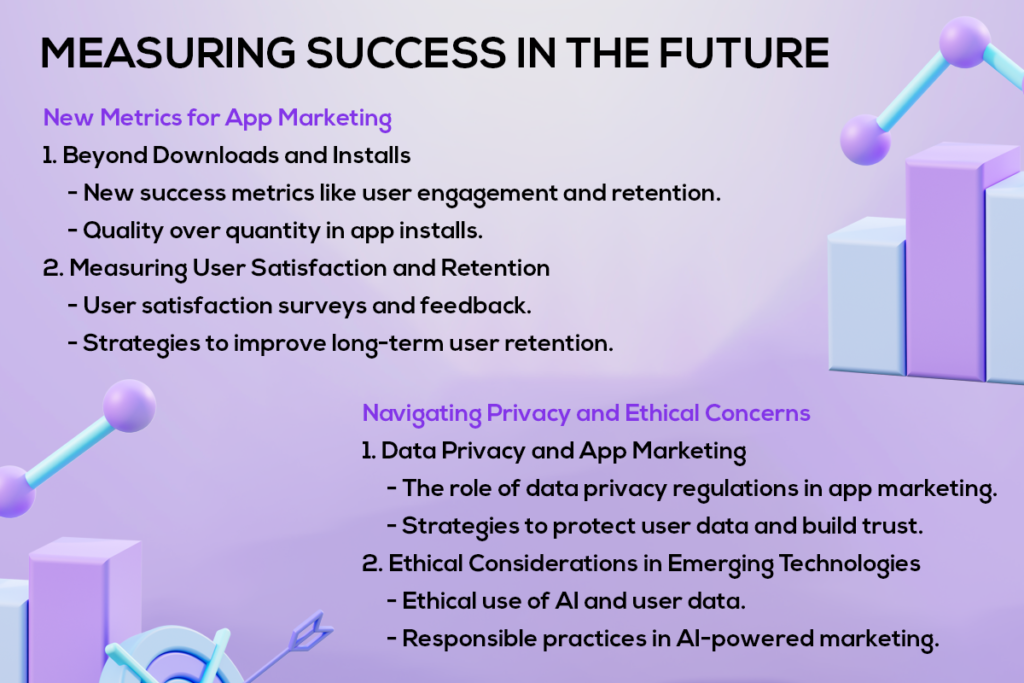
Measuring Success in the Future
App marketing in the future will necessitate a shift in how success is measured. Beyond traditional metrics like downloads, app marketers will focus on new criteria to evaluate app performance and user satisfaction. Here’s a comprehensive look at this evolving landscape.
New Metrics for App Marketing trends
The future of app marketing demands a paradigm shift in the way success is measured. New metrics will emerge as the primary indicators of an app’s performance and impact on users. Here, we explore the novel success metrics that will define the future of app marketing trends.
Beyond Downloads and Installs
In the evolving landscape of app marketing, the traditional benchmarks of success, such as raw download and install numbers, are no longer sufficient to measure an app’s true impact and value. App marketers are looking beyond these initial figures to gauge the effectiveness of their strategies and the quality of user acquisition. Here’s a deeper dive into the new standards for success:
User Engagement and Activation
Instead of merely acquiring users, app marketers will prioritize their activation and engagement. This involves tracking how users interact with the app immediately after installation, aiming for high activation rates and meaningful interactions.
- Activation Rate: Marketers will assess the percentage of users who complete key actions or tasks within the app shortly after installation. This metric is indicative of users who are genuinely interested in the app’s offerings.
- Engagement Metrics: App marketers will closely monitor user interactions, including the frequency of app use, feature utilization, and the time spent within the app. The goal is to ensure that users actively engage with the app and find value in it.
User Retention and Churn Rate
User retention becomes a critical metric for success, focusing on the app’s ability to retain users over time and reduce churn rates.
- Churn Rate: This metric measures the rate at which users stop using the app. Lower churn rates signify that users are finding continued value in the app and are less likely to abandon it.
- Cohort Analysis: To understand and improve retention, cohort analysis will be utilized to track how different user groups perform over time. Marketers will identify trends and implement strategies to enhance user retention.
Quality Over Quantity
The emphasis will shift from accumulating large user numbers to acquiring high-quality users who are genuinely interested in the app’s offerings.
- Targeted Acquisition: App marketers will adopt more targeted user acquisition strategies, reaching out to audiences that are more likely to engage with the app and convert into long-term users.
- App Install-to-Action Rate: This metric quantifies the percentage of users who install the app and then proceed to take desired actions, such as making a purchase or completing a registration. Higher app install-to-action rates signify the effectiveness of user acquisition.
User Lifetime Value (LTV)
LTV will continue to be a key metric but with a focus on measuring the long-term value that users bring to the app.
- LTV Segmentation: App marketers will segment users based on their long-term value, allowing for more targeted and personalized approaches to retain and nurture high-value users.
- Monetization and User Contribution: LTV will encompass not only monetary contributions but also the value that users bring to the app community, such as content creation, referrals, and social engagement.
These evolving metrics reflect the changing landscape of app marketing, emphasizing not only user acquisition but also user quality, engagement, and long-term value. By shifting the focus toward these metrics, app marketers will be better equipped to create sustainable and meaningful relationships with users.
Measuring User Satisfaction and Retention
Measuring user satisfaction and retention is an integral aspect of app marketing trends in the future. Beyond traditional metrics, app marketers will delve deeper into understanding how satisfied users are with the app and the strategies that keep them coming back. Here’s a closer look at these evolving measurement techniques:
User Satisfaction Surveys
To gauge user satisfaction, app marketers will increasingly use surveys and feedback mechanisms that capture users’ sentiments and opinions.
- Net Promoter Score (NPS): NPS surveys will become a standard practice to measure user satisfaction. Users are asked to rate their likelihood of recommending the app to others, providing valuable insights into user sentiment.
- In-App Feedback Forms: These allow users to express their opinions and provide feedback within the app itself, enabling real-time insights into their satisfaction levels.
Sentiment Analysis
Advanced sentiment analysis tools powered by natural language processing (NLP) and machine learning will be employed to understand user sentiment and emotional responses.
- Emotion Detection: These tools can identify emotional cues from user feedback, allowing app marketers to gauge not only satisfaction but also the emotional impact of the app.
- Trend Analysis: Sentiment analysis tools will provide trend insights, highlighting areas where users are particularly satisfied or dissatisfied, enabling targeted improvements.
User Retention Surveys
To better understand user retention, app marketers will conduct surveys that capture the reasons behind user churn or continued engagement.
- Exit Surveys: When users uninstall or discontinue app usage, they will be presented with exit surveys to collect data on why they left, offering valuable insights for app improvements.
- Long-Term Engagement Surveys: For users who continue using the app, long-term engagement surveys will gather data on their motivations and what keeps them coming back.
User Behavior Analytics
App marketers will employ advanced user behavior analytics to measure satisfaction and retention more accurately.
- User Flow Analysis: This involves analyzing the paths users take within the app, identifying areas where they drop off, and optimizing these sections to enhance user satisfaction and retention.
- Conversion Funnel Analysis: By scrutinizing the conversion funnel, app marketers can identify where users are most likely to disengage and make necessary adjustments.
User Interaction Patterns
Understanding how users interact with the app and recognizing specific behavioral patterns will be vital in measuring user satisfaction and retention.
- Feature Utilization Patterns: App marketers will closely track which features users engage with the most, enabling them to emphasize those areas for user satisfaction and retention strategies.
- Personalization and Recommendations: Utilizing user data, personalization and recommendation systems will enhance user satisfaction by providing tailored experiences and content.
These advanced measurement techniques are crucial for the future of app marketing trends, as they allow app marketers to gain deep insights into user satisfaction and retention, facilitating more informed strategies to enhance the overall app experience.
Navigating Privacy and Ethical Concerns
In the rapidly evolving landscape of app marketing, privacy and ethical concerns play a pivotal role in shaping user trust and regulatory compliance. App marketers must navigate these concerns to build trust and ensure ethical practices. Here’s a more in-depth exploration of this critical aspect.
Data Privacy and App Marketing
The intersection of data privacy and app marketing is a critical concern, shaping the way app marketers collect, handle, and utilize user data. Maintaining a high standard of data privacy not only ensures legal compliance but also builds trust with users. Here’s a more in-depth exploration of this significant aspect:
Transparency in Data Collection
App marketers must be transparent about the types of data collected and the purposes for which it’s used.
- User Consent: Prior and informed consent from users for data collection is not just a legal requirement but an ethical practice to respect user autonomy.
- Data Collection Notices: Clearly written and easily accessible data collection notices are vital, explaining what data is gathered and how it benefits the user.
User Data Security
Protecting user data from breaches and unauthorized access is a top priority.
- Encryption: Robust encryption protocols, both in transit and at rest, are non-negotiable to ensure data security.
- Secure Storage: App marketers must employ secure storage practices to safeguard user data against vulnerabilities.
Data Retention and Deletion
Users should have control over their data, including the ability to access, correct, or delete it.
- Data Retention Policies: App marketers must define clear data retention policies and adhere to them, allowing users to request data deletion.
- Data Portability: Providing options for users to export their data or move it to other services promotes user empowerment.
Third-Party Data Sharing
App marketers need to be cautious when sharing user data with third-party services or partners.
- Data Sharing Agreements: Transparent agreements with third parties outlining data sharing practices are vital.
- User Consent for Data Sharing: Users should be informed and give explicit consent for data to be shared with third parties.
Compliance with Regulations
App marketers must stay updated and compliant with data privacy regulations.
- GDPR: Compliance with the General Data Protection Regulation (GDPR) is essential when handling user data, especially for users in the European Union.
- Data Protection Officers: In some cases, appointing data protection officers or experts can ensure compliance with data privacy laws.
Data Access and Rectification
Users should have the ability to access their data and correct inaccuracies.
- User Dashboards: Providing user-friendly dashboards where users can view and edit their data is a valuable feature.
- User Support for Data Requests: Responsive user support for data access and correction requests is essential.
Privacy by Design
App marketers should implement privacy by design principles throughout the app development process.
- Data Minimization: Collect only the data necessary for the app’s functionality, reducing the risk of privacy breaches.
- Privacy Impact Assessments: Regular assessments of data processing activities can help identify and mitigate privacy risks.
Prioritizing data privacy in app marketing is not just a legal requirement; it’s a way to earn and maintain user trust. App marketers who embrace data privacy best practices are better positioned to succeed in an era where privacy-conscious users are increasingly discerning about how their data is handled.
Ethical Considerations in Emerging Technologies
As emerging technologies like AI and machine learning become central to app marketing trends, ethical considerations play a significant role in ensuring responsible and user-centric practices. Here’s a more comprehensive exploration of this crucial aspect:
Fairness and Bias Mitigation
AI algorithms have the potential to perpetuate biases, whether racial, gender, or cultural. App marketers must prioritize fairness and take steps to mitigate biases.
- Algorithm Auditing: Regular audits of AI algorithms to detect and rectify biases, ensuring equitable user experiences.
- Diverse Training Data: Incorporating diverse and representative datasets during the training of AI models to minimize bias.
User Consent for AI Use
Users should be informed and provide explicit consent for AI-driven marketing practices, including personalized recommendations and targeted advertising.
- Clear Communication: Transparently explaining to users how AI is used in marketing and its benefits to them.
- Opt-In and Opt-Out Options: Allowing users to opt in or out of AI-driven features, respecting their choices.
Algorithm Transparency
App marketers will be expected to provide insights into the functioning of AI algorithms used for marketing, ensuring that users understand how decisions are made.
- Explainable AI: Implementing explainable AI techniques that make AI-driven decisions more transparent and understandable.
- User Control: Enabling users to modify AI-driven recommendations or settings based on their preferences.
Responsible Data Handling
As AI relies heavily on data, responsible data practices are essential to protect user privacy and build trust.
- Data Encryption: Strong encryption and security measures for data storage and transmission.
- Data Anonymization: Anonymizing or pseudonymizing data to ensure user privacy, especially in personalized marketing.
User Empowerment
Empowering users to have control over their data and the algorithms that affect their experiences.
- User Preferences Dashboard: Providing user-friendly dashboards where users can manage their data settings and AI-driven recommendations.
- Data Portability: Allowing users to export their data or insights generated by AI to other services.
Oversight and Accountability
App marketers should establish oversight mechanisms and accountability for AI use in marketing.
- Ethics Committees: Forming ethics committees or appointing ethics experts to evaluate AI practices for ethical compliance.
- Continuous Monitoring: Regularly monitoring AI systems for potential ethical concerns and taking corrective actions.
User Feedback and Redress
Providing avenues for users to express concerns and seek redress for AI-related issues.
- User Support: Responsive user support for AI-related queries, issues, or complaints.
- Ethical AI Response Team: Designating a team responsible for addressing ethical concerns and inquiries related to AI use.
Ensuring that emerging technologies are used ethically and responsibly is not just a regulatory requirement; it’s a way to build user trust and ensure long-term success in app marketing. App marketers who prioritize ethical considerations are better positioned to navigate the dynamic landscape of AI-driven marketing while maintaining user trust.
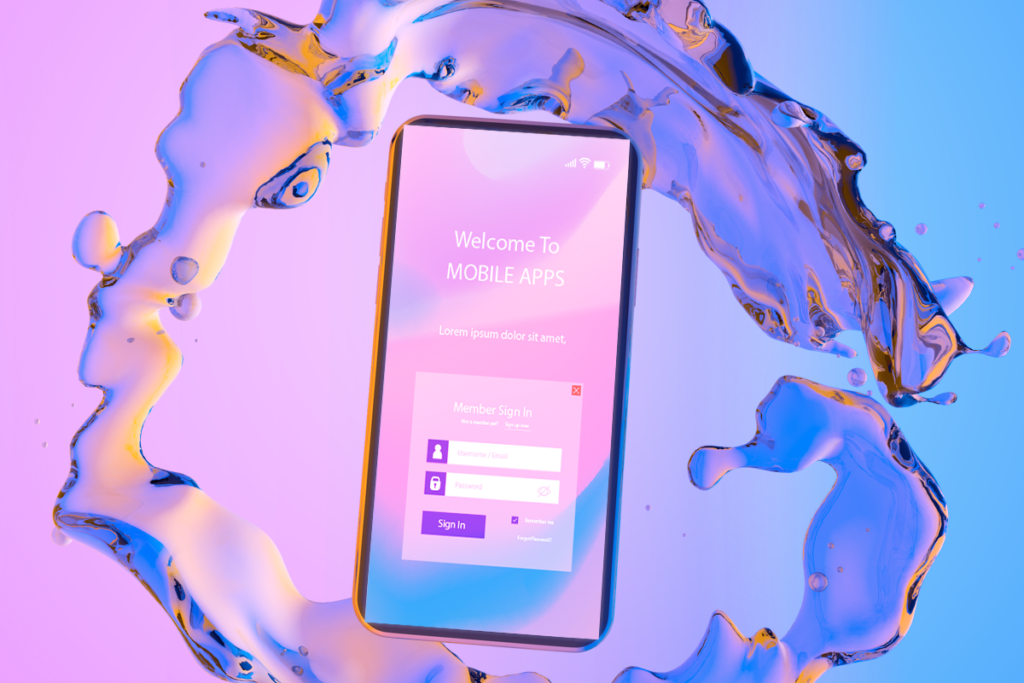
Conclusion
The world of app marketing trends is on the cusp of a profound transformation, driven by evolving consumer expectations and groundbreaking technologies. As we journey into the future, two fundamental principles remain at the heart of this transformation: adaptability and innovation.
The dynamic nature of app marketing necessitates a forward-thinking approach, as the landscape continually shifts with emerging trends and technologies. Adapting to these changes and embracing innovation are not just desirable but essential for app developers and marketers who aspire to stay relevant and competitive.
Staying ahead of emerging trends is paramount. From the evolving strategies in user acquisition and engagement to the integration of technologies like AI, AR, and VR, the app marketing ecosystem is evolving rapidly. User-centric marketing, with an emphasis on trust, loyalty, and authenticity, is becoming a defining factor in app success.
As the app marketing future unfolds, the definition of success is shifting beyond mere downloads and installs. New metrics that focus on user engagement, retention, and satisfaction are emerging as the gold standard. Ensuring user privacy and adhering to ethical principles in the utilization of emerging technologies like AI is not just a compliance requirement but a fundamental building block for user trust.
In this ever-evolving journey, app developers and marketers are encouraged to embrace the emerging trends, navigate the ethical considerations, and remain innovative. By doing so, they secure their place in the future of app marketing and continue to craft strategies that meet the evolving needs and expectations of app users.
Please feel free to Contact Us in case you need any guidance regarding your app marketing needs.
FAQ
What are some real-world examples of successful app marketing using emerging technologies?
Real-world examples of successful app marketing using emerging technologies can be found across various industries. For instance, companies like IKEA have leveraged augmented reality (AR) to allow users to visualize furniture in their homes before making a purchase. Additionally, fitness apps have embraced virtual reality (VR) to create immersive workout experiences. These examples demonstrate how emerging technologies enhance user engagement and provide value to app users.
How can app marketers ensure data privacy and ethical practices in AI-driven marketing?
Ensuring data privacy and ethical practices in AI-driven marketing requires a multi-faceted approach. This includes transparent communication with users about data usage, explicit consent for AI-driven features, strong data encryption, and data anonymization. App marketers should also implement explainable AI techniques, provide user control options, establish oversight mechanisms, and offer user feedback channels. By incorporating these measures, marketers can build user trust and adhere to ethical standards.
Are there challenges in implementing AR and VR in app marketing trends?
Implementing augmented reality (AR) and virtual reality (VR) in app marketing comes with its set of challenges. These challenges may include the high development costs of AR/VR content, the need for compatible hardware (e.g., VR headsets), and the requirement for engaging and immersive experiences. Additionally, ensuring that AR/VR experiences align with the app’s objectives and user preferences is a critical consideration.
How does customer-centric marketing impact user retention?
Customer-centric marketing significantly impacts user retention by focusing on building trust and loyalty. By implementing transparent communication, loyalty programs, and personalized experiences, app marketers create a positive user environment. This, in turn, fosters user loyalty and trust, resulting in longer-lasting user relationships, increased engagement, and reduced churn rates.
Can traditional marketing still be effective in the future of app marketing trends?
While emerging technologies and user-centric strategies are shaping the future of app marketing trends, traditional marketing methods can still be effective. Traditional marketing, such as email marketing, content marketing, and search engine optimization, continues to play a role in the app marketing ecosystem. The effectiveness of traditional marketing depends on the app’s target audience, industry, and objectives. App marketers should adopt a balanced approach that combines both traditional and innovative methods to maximize their reach.
What are the potential risks of overreliance on AI in app marketing?
Over Reliance on AI in app marketing can lead to several risks, including reduced user privacy, over-personalization, and algorithmic biases. Privacy concerns may arise if users feel that their data is excessively monitored or utilized. Over-personalization can make users feel overwhelmed or that their choices are limited. Additionally, algorithms can inadvertently perpetuate biases if not carefully monitored. App marketers must strike a balance between AI-driven personalization and respecting user preferences.
How can app marketers stay updated on emerging trends and technologies?
App marketers can stay updated on emerging trends and technologies through various means. This includes attending industry conferences, participating in webinars, following industry-specific blogs and publications, and actively engaging with relevant online communities. Joining professional networks and associations can also provide opportunities for learning about the latest developments in app marketing. Networking with peers and experts in the field is invaluable for staying current.
Are there regulatory concerns related to the future of app marketing?
Yes, there are regulatory concerns related to the future of app marketing. Data privacy regulations, such as the General Data Protection Regulation (GDPR) and the California Consumer Privacy Act (CCPA), impact how user data is collected and used. Additionally, there may be industry-specific regulations and guidelines. App marketers must ensure compliance with these regulations to avoid legal repercussions and build user trust.
Can emerging technologies help small app businesses compete with larger competitors?
Emerging technologies can indeed help small app businesses compete with larger competitors. Technologies like AI, AR, and VR offer innovative ways to engage users and create unique experiences. Smaller businesses can leverage these technologies to differentiate themselves and provide value to their target audience. The key is to strategically implement these technologies to meet specific user needs and preferences.
What impact will the Metaverse have on the future of app marketing trends?
The Metaverse, an interconnected virtual reality space, is expected to have a profound impact on app marketing trends. As the Metaverse evolves, app marketers will explore new ways to engage users within this immersive digital space. It offers opportunities for interactive storytelling, virtual product trials, and innovative marketing experiences. However, marketers should also consider the ethical implications and data privacy concerns of the Metaverse.




0